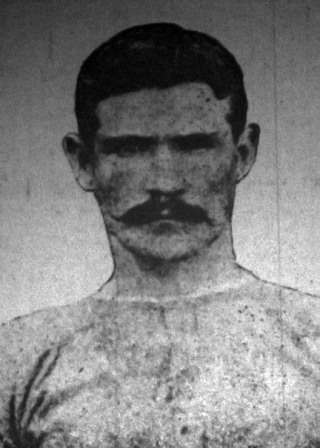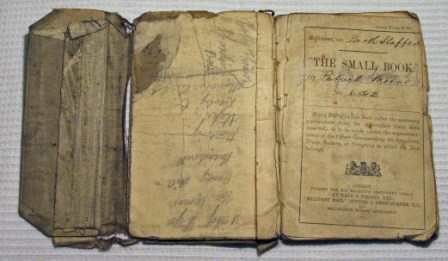
MOORE, PATRICK (‘Paddy’)

Photograph with kind permission from the Uttoxeter Advertiser [1c].
This photograph was taken from a picture of a group of regimental Scouts photographed in India in 1908. [1c]
|
|
Source |
||||
|
CWGC |
SDGW |
Uttoxeter Advertiser |
Other |
||
|
Parents |
Henry and Ann Moore |
|
|
|
9a, 9b |
|
Position in the family |
3rd child and 2nd son |
|
|
|
9a |
|
Where born |
Uttoxeter |
|
Yes |
1c |
2, 9a |
|
When born |
1882 or 1883 |
|
|
|
5 |
|
About 1883 |
|
|
|
9a |
|
|
About 1884 |
|
|
|
9b |
|
|
Address |
5, Church Street, Uttoxeter (self) |
|
|
1d |
|
|
Church Street, Uttoxeter |
|
|
1a, 1b, 1c |
2 |
|
|
13 James Street (brothers and sisters) |
|
|
1e |
|
|
|
Spouse |
Yes |
|
|
1c |
|
|
Children |
1 infant son, who died at nine weeks |
|
|
1c, 1d |
|
|
Employment Before Joining up |
Messrs Goodwin Brothers, Market Place, Uttoxeter |
|
|
1b |
|
|
Military service before the war |
Regular soldier for 8 years, then 2 years on Reserve |
|
|
1b |
|
|
Regular soldier from 18th of June 1901 |
|
|
|
4c |
|
|
Home service from 5 Feb 1903 – 3 Oct 1903 |
|
|
|
4d |
|
|
Served in India from 26 October 1903 |
|
|
|
4d |
|
|
Reservist |
|
|
|
2 |
|
|
When enlisted |
Recalled on 5 August 1914 |
|
|
1c |
|
|
Where enlisted |
Uttoxeter |
|
Yes |
|
2 |
|
Corps |
III |
|
|
|
7a |
|
Division |
6th |
|
|
|
7a |
|
Brigade |
17th |
|
|
|
7a |
|
Regiment |
North Staffordshire (Prince of Wales’s) |
Yes |
Yes |
1b, 1c, 1f |
2, 2b, 3, 4a, 4b |
|
Unit |
1st Bn. |
Yes |
Yes |
1c |
2, 2b |
|
Rank |
Private |
Yes |
Yes |
1c, 1e, 1f, 1g |
2, 2b, 3 |
|
Service Number |
6842 |
Yes |
Yes |
|
2, 2b, 4a, 4b, 4c |
|
6843 (WRONG) |
|
|
|
3 |
|
|
Date of Death |
5 November 1914 |
Yes |
|
1c, 1e, 1f, 1g |
2, 3 |
|
Age at time of death |
31 |
|
|
1c, 1e |
|
|
Where Killed or died |
In No. 7 Stationary Hospital in Boulogne |
|
|
|
3 |
|
France/Flanders |
|
Yes |
|
|
|
|
How he died |
Died of wounds |
|
|
1c, 1e, 1f |
2, 3 |
|
Location of Grave or Memorial |
Boulogne Eastern Cemetery – Grave III. B. 43. |
Yes |
|
|
|
|
Awards |
|
|
|
|
|
|
Where commemorated |
De Ruvigny Roll of Honour |
|
|
|
3 |
|
Uttoxeter Town War Memorial |
|
|
|
2 |
|
Patrick’s parents were Irish [9a], but he was a native of Uttoxeter. [1c, 9a]
One of Patrick’s sisters was Miss Annie. Moore ,[9a] of 13 James Street, Uttoxeter. [2]
He was a Regular soldier for 8 years, then 2 years on Reserve before being recalled on 5 August 1914. [1b]
Before the war he had served with the North Staffordshire Regiment, principally in India, and was a Regimental Boxing Champion. [1c] While in India he was one of the finest exponents of boxing in his regiment and had won many competitions. [1c]
Patrick’s family have preserved his Soldier’s Small Book. This is an immensely personal memento from his service in the army because he will have carried it with him at all times. It gives a valuable insight into life in the army and contains a wealth of information ranging from rules and regulations to advice on washing clothing, foot care, preparation of food in the field and even his will form.

Patrick served with the British Expeditionary Force [1a, 3] and was therefore one of the ‘Old Contemptibles’
The Old Contemptibles have become famous for their wonderful discipline, tenacity and courage. Although hugely outnumbered, they held the German army at bay and bought the French nation the time that they needed to mobilise and put their army in the field. If it had not been for the consummate skill, gritty determination and resilience of the Old Contemptibles in the face of enormous hardships, the war would have been lost in the opening months.
Having previously served as a regular soldier, Patrick was called back to the colours on the 5th of August 1914, the day after war was declared.[2]
In their obituary for Patrick, the Uttoxeter Advertiser [1c] said that when the North Staffordshire Regiment was proceeding to the South of England, prior to embarkation, they were at Cambridge for a short time, and whilst there a brother of Mr. W. Wood, of the Market Square, photographed several groups of soldiers. By a strange coincidence, one of the photographs showed Patrick and James Nuttall sitting together. Unfortunately, we have not been able to trace the photograph yet.
James Nuttall, incidentally, was killed in action only two weeks before Patrick died of his wounds.
Patrick was present during the closing stages of the Miracle of the Marne, in which the progress of the German army was checked and then reversed by the British and French troops.
He also took part in the ‘Race to the Sea’, in which the allied and German forces tried to outflank one another as they raced across France and Belgium to take the Channel ports. In the process they dug parallel trench systems and established the Western Front that would remain virtually static until the end of the war.
During the closing stages of the Race to the Sea, the two armies reached deadlock in which neither side could take the opposing trenches by frontal attack. The British trench systems around Ypres bulged out into the German-occupied ground, forming a salient.
In all of these engagements the Old Contemptibles fought with such courage and determination that their exploits have become legendary. We believe that Patrick was probably killed during the First battle of Ypres, when the Germans tried to pinch the Ypres salient out by attacking from the north and south simultaneously. Fighting was intense and both sides bombarded the other almost continuously.
In November 1914 the Uttoxeter Advertiser reported that Patrick had been seriously wounded. [1b] Neither his wife nor his relatives received any official details of what had happened to him, but Private G. Hoptroff, another Uttoxeter man serving in the same regiment, wrote to his own parents and told them that Patrick had been wounded in the back in two places and was in a dangerous condition. [1b] He had received his injuries while on action in the ‘recent fighting’. [1b]
He later died from these wounds in Boulogne hospital.
Patrick’s wife was not informed of his death until the end of November, by which time the Uttoxeter Advertiser had known for two weeks. The obituary that was published in the Uttoxeter Advertiser [1c] said the following:
“Moore was reported wounded some time since, and although the wounds were stated to be of a serious nature, it was hoped that his strong constitution would pull him round. Over a fortnight ago, however, we received a report of his death from a soldier at the front, but for obvious reasons we were averse to publishing the information until an official confirmation was received by the relatives...”
At the time of his death, he and his wife had only been married for 15 months. [1c] This was a terrible time for the Patrick’s wife because only a few weeks before his death they had lost an infant son (Patrick Jr.) at just 9 weeks old. [1c, 1d]
Patrick was mentioned during the memorial service held for Oswald Bamford in 1915. For details, see Oswald’s notes.
It is proving difficult to determine exactly what happened to Patrick, but it would appear that he probably received his fatal wounds during the First Battle of Ypres. We have certainly established that his unit was engaged in the battle during the days preceding his death, but we do not know how long he lived after receiving his wounds. We cannot, therefore, be entirely certain whether he was wounded towards the end of the ‘Race to the Sea’ or during the First Battle of Ypres. Either way, we believe that he will have been in the Ypres area
Patrick died of his wounds on the 5th November 1914. We know from the Uttoxeter Advertiser that he was seriously wounded in two places in his back, and given that he was seriously wounded, it seems reasonable to assume that he did not live for very long after being evacuated from the front line.
In the days leading up to the 5th of November, the Regimental War diary yields several possible events during which he could have received these wounds. They all involved shelling, which would be consistent with Patrick’s injuries.
Note also the references to messages of congratulations that were received from various quarters for the gallantry shown by the Regiment in the recent engagements. It was such gallantry that won the Old Contemptibles their reputation.
Unfortunately, the regular army units were very traditional in their attitudes to Officers and ‘Other Ranks’. They always recorded the names of Officers when they were killed or wounded, but they did not list the names of casualties from the ‘other ranks. Consequently, we cannot tell from the entries in the War Diary which group of casualties included Patrick.The memorial notices that follow were posted in the Uttoxeter Advertiser to mark the anniversaries of his death:
|
This was posted in November 1916 [1e] to mark the second anniversary of his death |
|
|
This marked the fourth anniversary, in November 1918 [1f] |
|